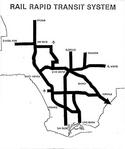“Fostering livable communities...is a transformative policy shift for U.S. DOT,” announced grandiloquently the Draft U.S. DOT Strategic Plan released for public comment on April 15, 2010. But what exactly does the Administration mean by “livability” and how does it intend to translate this vague rhetorical abstraction into a practical reality? read more »
Transportation
Is It Game Over for Atlanta?
With growth slowing, a lack of infrastructure investment catching up with it, and rising competition in the neighborhood, the Capital of the New South is looking vulnerable.
Atlanta is arguably the greatest American urban growth story of the 20th century. In 1950, it was a sleepy state capital in a region of about a million people, not much different from Indianapolis or Columbus, Ohio. Today, it's a teeming region of 5.5 million, the 9th largest in America, home to the world's busiest airport, a major subway system, and numerous corporations. Critically, it also has established itself as the country's premier African American hub at a time of black empowerment. read more »
When Saving 90% is Not Enough: The Transit Savings Report
The American Public Transportation Association (APTA) is publishing monthly Transit Savings Report to illustrate the purportedly great savings that can be achieved by giving up the car and traveling by transit instead. APTA compares the average cost of buying a monthly transit pass to replace a car, which is assumed to travel 15,000 miles annually. read more »
The Muddled CNT Housing and Transportation Index
The Center for Neighborhood Technology (CNT) has produced a housing and transportation index (the "H&T Index"), something that has been advocated by Secretary of Housing and Urban Development (HUD) Shaun Donovan and Secretary of Transportation Ray LaHood. The concept is certainly worth support. Affordable housing and mobility are crucial to the well-being of everyone, which translates into a better quality of life, more jobs and economic growth. read more »
Telecommute Taxes On The Table
The Obama Administration has recently been shining a spotlight on the need to eliminate barriers to telework and its growth. Now Congress has legislation before it that would abolish one of telework's greatest obstacles, the risk of double taxation Americans face if they telecommute across state lines. The Telecommuter Tax Fairness Act (H.R. 2600)would remove the double tax risk.
H.R. 2600 can and should be enacted as a stand-alone measure. However, Washington is also currently developing or considering a variety of other legislative packages, any one of which would be significantly strengthened if the provisions of H.R. 2600 were added to it. These packages include energy/climate legislation (expected to be unveiled later this month), transportation legislation and small business legislation. Each of these packages, we have been told, would double as a jobs bill. read more »
- Login to post comments
Reconnecting the In-between City
The socio-spatial landscape of what we call the “in-between city,” includes that part of the urban region that is perceived as not quite traditional city and not quite traditional suburb (Sieverts, 2003). This landscape trepresents a the remarkable new urban form where a large part of metropolitan populations live, work and play. While much attention has been focused on the winning economic clusters of the world economy and the devastated industrial structures of the loser regions, little light has been shed on the urban zones in-between. read more »
Transit in Los Angeles
Los Angeles officials hope to convince Congress take the unprecedented step of having the US Treasury to front money for building the area’s planned 30 year transit expansions in 10 years instead. The money would be paid back from a one-half cent sales tax (Measure R), passed by the voters in 2008. That referendum required 35% of the new tax money to be spent on building 12 rail and exclusive busway transit lines.
Measure R was not the first instance of Los Angeles officials committing to spend 35% of a new one-half cent sales tax on new transit lines. read more »
Ruining our Cities to Save Them
Latching onto Kevin Rudd’s call for “a big Australia” and forecasts that our population will grow by 60 per cent to 35 million in 2050, urban planners are ramping up their war against suburbia. In paper after paper, academics across the country have been pushing the same line. Climate change, peak oil and the financial crisis mean we can’t go on driving and borrowing for low-density housing. read more »
Forced March To The Cities
California is in trouble: Unemployment is over 13%, the state is broke and hundreds of thousands of people, many of them middle-class families, are streaming for the exits. But to some politicians, like Sen. Alan Lowenthal, the real challenge for California "progressives" is not to fix the economy but to reengineer the way people live. read more »
Transit Oriented Development: If Not San Francisco, Where?
“The Great Transit Oriented Development Swindle?” reads the headline in the Fog City Journal, one of the growing number of internet newspapers providing serious, professional web-based journalism as an alternative to declining print newspapers (and their often less than effective web sites).
The article does not directly answer the question in the headline, but certainly provides enough ammunition to what has become a commonly accepted mantra among planners and urban boosters. It reveals how transit oriented development (TOD) is often based upon fragile foundations that amount to an ideological swindle. It is important to recognize that the Fog City Journal is no right wing or libertarian organ. There is little market for that in the city of San Francisco. read more »




















